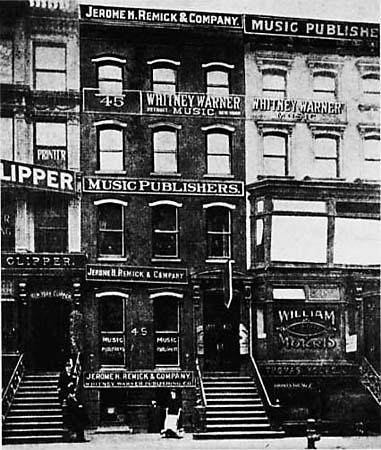 American popular music in the early 20th century was centered in New York City, specifically in an area known as "Tin Pan Alley." Tin Pan Alley initially referred to a precise location: 28th Street between 5th and 6th Avenues. However, as the popular music industry blossomed and attracted more and more songwriters and publishers, the name shifted to refer to these New York City songwriters and music publishers, rather than the original location. The musicals on Broadway, a popular venue for American music in the early 1900s, often pulled from the songs written in Tin Pan Alley, which helped increase the popularity of Tin Pan Alley composers. Some of the most popular of these composers are Irving Berlin, George and Ira Gershwin, Scott Joplin, and Harry and Albert Von Tilzer. Notable publishers from Tin Pan Alley include Leo Feist; M. Whitmark & Sons; Waterson, Berlin & Snyder, Inc.; and Shapiro, Bernstein & Co. Most of the sheet music in this section was published in New York City, some under predominant Tin Pan Alley publishers like Leo Feist and Shapiro, Bernstein & Co.
American popular music in the early 20th century was centered in New York City, specifically in an area known as "Tin Pan Alley." Tin Pan Alley initially referred to a precise location: 28th Street between 5th and 6th Avenues. However, as the popular music industry blossomed and attracted more and more songwriters and publishers, the name shifted to refer to these New York City songwriters and music publishers, rather than the original location. The musicals on Broadway, a popular venue for American music in the early 1900s, often pulled from the songs written in Tin Pan Alley, which helped increase the popularity of Tin Pan Alley composers. Some of the most popular of these composers are Irving Berlin, George and Ira Gershwin, Scott Joplin, and Harry and Albert Von Tilzer. Notable publishers from Tin Pan Alley include Leo Feist; M. Whitmark & Sons; Waterson, Berlin & Snyder, Inc.; and Shapiro, Bernstein & Co. Most of the sheet music in this section was published in New York City, some under predominant Tin Pan Alley publishers like Leo Feist and Shapiro, Bernstein & Co.
World War I music, much like other cultural creations such as books and TV shows, is an illuminating product of its time, providing insight into the various popular sentiments prevailing in America during the war. These sentiments and themes include antiwar feelings, reluctance, loss, patriotism, inspiration, and dedication to the war effort.
The role of women in the sheet music is varied. Some of the pieces feature a female songwriter and/or vocalist. However, many of the pieces feature women on the covers, showing them either as passive or active agents in the war. Pieces in which women seem passive and helpless tend to be more sentimental and show women being left behind or reluctantly saying goodbye as the men go off to war (see, for example, "I Didn't Raise My Boy to Be a Soldier"). Then there are the songs where women are depicted as taking an active role in aiding the war effort, such as "I'm Going to Follow the Boys" and "(And Then She'd) Knit, Knit, Knit." In addition to showing women in active and passive roles during the war, the songs highlight circumstances in which many women found themselves, whether it was having a father, son, or husband go off to war or taking part in the home front war efforts.
Further Resources
"Popular Songs of World War I," University of California, Santa Barbara Library.
"The Voices and Music of World War I," University of Missouri-Kansas City University Libraries.
Image Source:
"Buildings of Tin Pan Alley, 1910," Wikimedia Commons, JPEG file, http://upload.wikimedia.org/wikipedia/commons/c/c8/Tinpanalley.jpg (accessed April 30, 2015).

